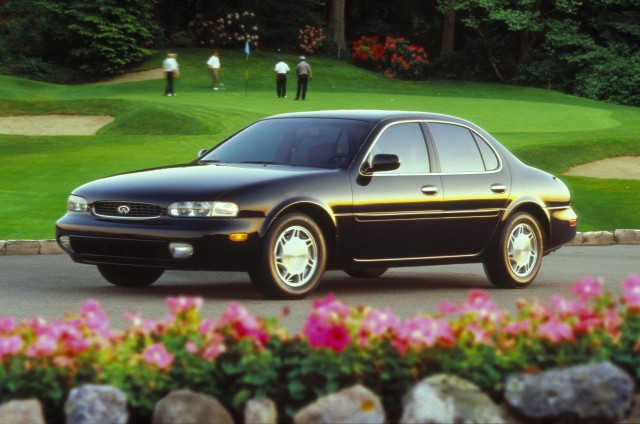
The Infiniti J30 came out of nowhere in the US, but in Japan it was the successor to the second-generation F31 Leopard, sold as the Infiniti M30 in the US. The angular Leopard, available only in coupe form, was quite popular in Japan, despite moderate sales stateside. It would seem odd, then, that the follow-up would be a confusing change of direction into a four-door sedan with one of the most rounded shapes of its era. It perhaps even unintentionally pioneered the body style of the currently very en vogue “four-door coupe”, the most aggravating term in the automotive lexicon second only to “auto-shift manual.”
To fully understand why, we have to look at its home market, where Nissan had just been put on the defensive, and where a dizzying array of Bubble Era dealership chains. owned by the same manufacturer. Toyota had just come out with the Giugiaro-designed Toyota Aristo, and to compete, Nissan wanted to turn the Leopard into a sporty luxury mid-size sedan.
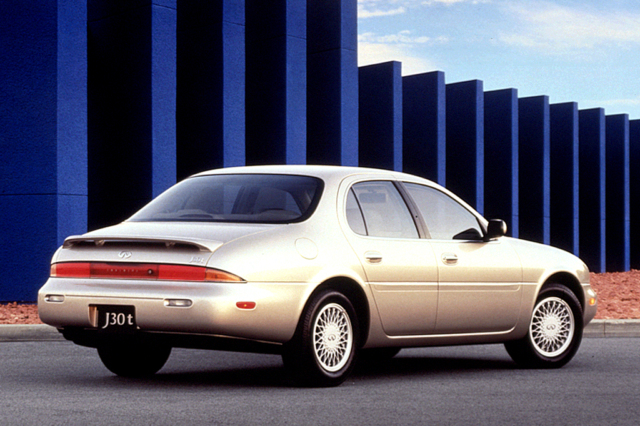
The previous Leopard had been sold at Nissan Bluebird stores, alongside cars like the Z32 Fairlady Z, known as the 300ZX stateside. This meant they had two competing grand touring coupes next to each other on the showroom floor, and nothing to compete with the Aristo. The Fairlady Z name was as important to Nissan as the Corvette name is to Chevrolet, so naturally the Leopard had to be the one to change. It made sense, as the original F30 Leopard was available as a sedan.
Meanwhile in America, the M30 didn’t quite set the market ablaze like Infiniti had hoped, while the 300ZX was selling like gangbusters. All the cards were stacked against the coupe-y F31. A transformation into a sedan had to take place.
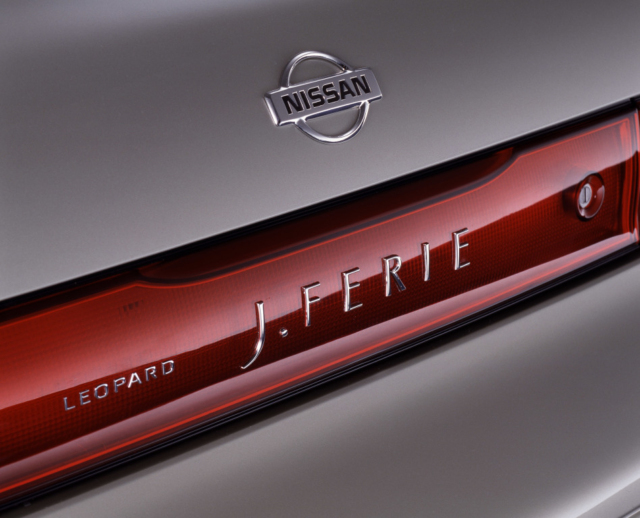
So when it came time for the third generation, Nissan abandoned the “F” chassis code, and built it atop the Cedric and Gloria Y platform, giving the chassis code JY32. It was officially christened the Nissan Leopard J. Ferie — meaning “holiday” in French — and sent to market.
The unique styling of the J30 came from the Nissan Design America studio in La Jolla, California. Doug Wilson, under the direction of Jerry Hirschberg, who told the press at the time, “Instead of designing a smaller version of the Q45, we wanted the J30 to be a distinctive member of the Infiniti line.”
They did away with the angular wedge shapes from the previous 20 years and opted instead for an organic egg shape. Nary a straight line could be found, and it featured a tapered rear end that can be found on many a modern four-door coupe design, such as the Volkswagen CC, Audi A7, and Mercedes CLA.The J30 claimed drag coefficient of 0.35, quite low for a sedan of the era. From the outside the car was like nothing else on the road, a rare feat for a mid-range mass-production car.
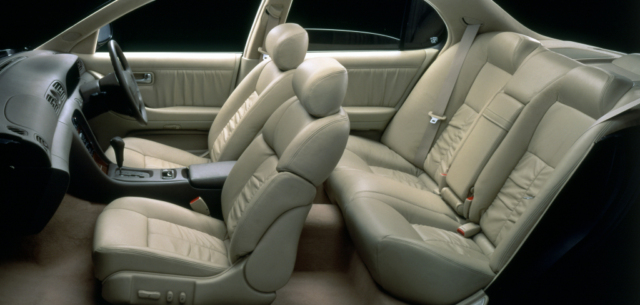
Even with its avant garde exterior, its styling was not the main selling point. That honor would go to its interior. Its seats and interior accoutrements were built by renowned furniture maker Poltrona Frau. The Italian firm has been at the cutting edge of nearly every luxury furniture design movement, from the deco craze of the 1930s to Memphis Milano style of the 1980s. Ninety-five percent of their pieces are hand-made, and the J30 interior was no exception, with a mere 5 seats made per day. In Japan, the Poltrona Frau leather seats were an $8,000 option.
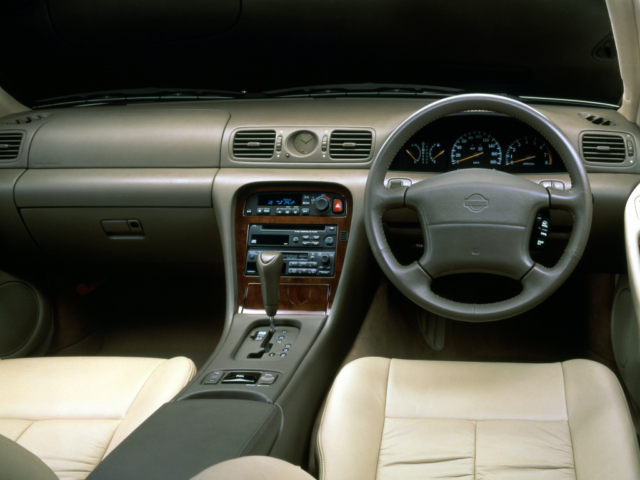
The exotic furniture branding was an attempt to add an air of exclusivity to the car, but that wasn’t the only attempt made. Like the Q45, it sported a contrasting dash, unusual at the time, and an analog clock, a touch of class used only in old world brands like Maserati and Jaguar at the time. All switchgear was also crafted to be soft-touch with smooth movement, not the cheap clicks that standard ABS plastic buttons provide. Since it was the era when automobile stereos began to vastly improve, Bose designed the stereo system with a optional multi-disc CD changer mounted in the trunk.

The opulence didn’t end with the interior. Infiniti wanted a car that drove briskly, yet still cosseted the occupants in a serene cocoon of luxury. With 210 horsepower on tap from the VG30DE, motive force was right on par with 6-cylinder offerings from Europe. In an effort to optimize smoothness, the tuning included an innovative method of taking the harshness out the automatic by momentarily retarding ignition while the 4-speed shifted gears.

Although the V6 option was well received by the press of the era, in typical Nissan fashion the best version was kept for Japan. There, the Leopard J. Ferie could be optioned with the 276-horsepower VH41DE V8 that we got in the Q45. Remember, that was the official number on paper. It still fell under the era of the Gentleman’s Agreement, and Nissan officially tested the car with variable valve timing disabled to fall under the agreement’s 276 horsepower limit.
With the valve timing control engaged, it’s rumored that the V8 generated 310 horsepower. If it had been offered stateside, the “J41” would have been one of the most interesting cars in the Infiniti portfolio.

The J30’s handling of the car was fantastic for the era, with independent suspension all around and a viscous-coupling LSD. Sound absorbent foam was injected into the chassis as noise insulation, but also served to stiffen the chassis without adding excessive weight. Super-HICAS four-wheel steering was available on the J30t (t for Touring) trim level, along with slightly beefier springs and sway bars.
Unfortunately, the J30 never caught on in America. The dimensions were a bit awkward for our market, as the styling gave it the body of a mid-size but interior space closer to that of a compact. Like the Mercedes 190E a few years prior, this was a quirk it could not overcome.
In Japan, the Leopard J. Ferie fared a little better than the American J30, but it’s hard to call it a sales home run. Though Japanese buyers gave the design a strong reception, the luxury sedan market was extremely crowded. Nissan alone had the Cefiro, Cedric, Gloria, Cima and President all with trim levels equal to or better than the J. Ferie. Add Toyota and Honda in to the mix, and it faced some stiff competition.
Japan’s deteriorating economy meant the V8 was a tough sell, and unlike many competitors the Leopard J. Ferie didn’t offer a 2.0-liter engine option to fall into the Japanese registration tax sweet spot. It seems Nissan got it backwards with this car, and global sales struggled to pass 7,000 cars internationally throughout its 1992-97 lifespan.
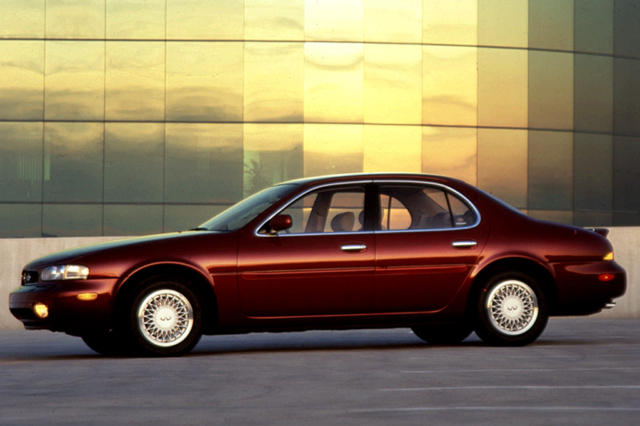
Nissan has historically been more willing to take risks than others, with cars like the Stanza Wagon, Pulsar EXA, and more recently, the Murano CrossCabriolet. The Infiniti J30 is one of these cars that might have been too far ahead of it’s time, but hopefully it will get it’s just recognition soon. This week, Infiniti will have one on display in Pebble Beach during Monterey Car Week, among other historic Japanese cars, so perhaps it’s time. It was truly one of the most interesting Infiniti products in the marque’s history, yet seems to have been largely forgotten. So if you’re looking for a 90s luxury sedan, rather than the standard Lexuses and Acuras, do yourself a favor and consider the Infiniti J30.
Images courtesy of Nissan.






Bringing my 1997J30T to the JCCS net month. By the way, the last production run of J30 was originally meant to be a 1998 model, but Renault killed the 98 in favor of the I30. So, although the VIN was rolled to 1998, the cars were sold as 1997 models [sort of 97 1/2/]. You can tell them by the VIN and the door air bags.
American car model year systems are really misleading and stupid to me. Here the model year of a car means the year it was built in and nothing else.
I think the phrase “organic egg shape” is all one needs to know as to why the J30 never sold well in the US. While I look at many shapes in nature and think how great they would translate to a car design I have never had that thought while looking at my breakfast eggs prior to cracking them open for sustenance.
The more inelegant descriptor was “slippery turd” design.
I agree except I have always reserved that phrase for the third generation Ford Taurus.
Nissan should have left the Leopard as a coupe for Infiniti, and instead, imported yet another luxury car that was left off the list…Nissan Laurel…the luxury twin of the Skyline. The Laurel would have been a perfect fit as a junior to the Q45 (President) as an Infiniti, while the Leopard (M30) would have remained as an alternative to the Toyota Soarer (Lexus SC400) and the Acura Legend Coupe. The Leopard originally started out as a sedan and a coupe, then the sedan got cancelled with the next generation, then the coupe got cancelled and the sedan came back.
Ah, but the Mazda 929 Luce was more elegant.
Always thought it had a horridly uglybland exterior and that hasn’t changed. Nice interior though. I really dislike most Nissan design from the 90s. Thankfully their interesting cars were spared, but the Sentra, 200SX, Altima, Maxima, J30, and Quest were all just about the ugliest cars in their classes.
And a .35 cd is mediocre, the 95 LS400 has a .29 Cd (an actually impressive number) and has handsome strong looks. This thing looks droopy and slimy and its not even very aerodynamic for it. Sad.
People hate on the J30 because of the rear slope, but there were other cars like the Ford Taurus and ZX2 escort.. It was a trend for a couple cars.
I actually do like the J30 and wish they had the V8 version the Leopard J Ferie had.
12 yrs ago, I was in contact with the Leopard J Ferie owner’s club in Japan. Many have disbanded their cars, but few do remain.
Is there a J30 club out there? As with everything people follow certain cars. So I figure there must be a club or forum out there.
Am I the only person who sees a striking similarity with the first generation Nissan Altima?